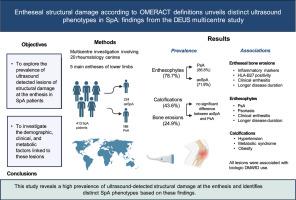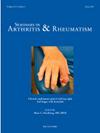Entheseal structural damage according to OMERACT definitions unveils distinct ultrasound phenotypes in SpA: findings from the DEUS multicentre study
IF 4.4
2区 医学
Q1 RHEUMATOLOGY
引用次数: 0
Abstract
Objectives
To explore the prevalence and distribution of ultrasound-detected lesions indicating structural damage at the enthesis (e.g., bone erosions, enthesophytes, and calcifications) in patients with spondyloarthritis (SpA), comparing those with axial spondyloarthritis (axSpA) and psoriatic arthritis (PsA), and to investigate the demographic, clinical, and metabolic factors linked to these lesions.
Methods
A cross-sectional analysis was conducted using data from the DEUS study, a multicentre investigation involving 20 rheumatology centres and including 413 patients with SpA (224 with axSpA and 189 with PsA). All participants underwent standardized clinical and ultrasound assessment of the large lower limb entheses (quadriceps tendon, proximal and distal patellar tendons, Achilles tendon, and plantar fascia). Entheseal structural lesions were explored by ultrasound and classified according to OMERACT definitions. Bivariate analyses and multivariate logistic regression were used to assess associations between ultrasound lesions and SpA patients’ characteristics.
Results
In SpA patients, enthesophytes were the most common lesion (78.7 %), followed by calcifications (43.6 %) and bone erosions (24.9 %). Enthesophytes were more prevalent in PsA (86.8 %) compared to axSpA (71.9 %) (p < 0.001), with no significant differences in erosions and calcifications. However, lesion distribution varied across different entheses.
Multivariate analysis revealed that entheseal erosions were significantly associated with inflammatory markers, HLA-B27 positivity, clinical enthesitis, and longer disease duration. Enthesophytes were significantly linked to PsA, psoriasis, clinical enthesitis, and longer disease duration. Calcifications were positively associated with hypertension, metabolic syndrome, and obesity. All lesions were associated with biologic DMARD use.
Conclusions
This study reveals a high prevalence of ultrasound-detected structural damage at the enthesis and identifies distinct SpA phenotypes based on these findings.

根据OMERACT定义,软组织结构损伤揭示了SpA中不同的超声表型:来自DEUS多中心研究的发现
目的探讨超声检测的椎体关节炎(SpA)患者椎体结构损伤(如骨侵蚀、内生菌和钙化)的患病率和分布,并与轴向性椎体关节炎(axSpA)和银屑病关节炎(PsA)进行比较,并调查与这些病变相关的人口统计学、临床和代谢因素。方法采用DEUS研究的数据进行横断面分析,DEUS研究是一项涉及20个风湿病中心的多中心调查,包括413例SpA患者(224例axSpA患者和189例PsA患者)。所有参与者对下肢大肌腱(股四头肌肌腱、髌骨近端和远端肌腱、跟腱和足底筋膜)进行了标准化的临床和超声评估。超声探查垂体结构病变,并根据OMERACT定义进行分类。采用双变量分析和多变量logistic回归来评估超声病变与SpA患者特征之间的关系。结果SpA患者最常见的病变为内生菌(78.7%),其次为钙化(43.6%)和骨侵蚀(24.9%)。与axSpA(71.9%)相比,PsA(86.8%)中内生植物更普遍(p < 0.001),在侵蚀和钙化方面没有显著差异。然而,病变分布在不同的窝中有所不同。多因素分析显示,肠末糜烂与炎症标志物、HLA-B27阳性、临床肠末炎和病程延长显著相关。内生菌与PsA、牛皮癣、临床肺源性炎症和较长的病程有显著关系。钙化与高血压、代谢综合征和肥胖呈正相关。所有病变均与生物DMARD使用有关。本研究揭示了超声检测到的末端结构损伤的高患病率,并根据这些发现确定了不同的SpA表型。
本文章由计算机程序翻译,如有差异,请以英文原文为准。
求助全文
约1分钟内获得全文
求助全文
来源期刊
CiteScore
9.20
自引率
4.00%
发文量
176
审稿时长
46 days
期刊介绍:
Seminars in Arthritis and Rheumatism provides access to the highest-quality clinical, therapeutic and translational research about arthritis, rheumatology and musculoskeletal disorders that affect the joints and connective tissue. Each bimonthly issue includes articles giving you the latest diagnostic criteria, consensus statements, systematic reviews and meta-analyses as well as clinical and translational research studies. Read this journal for the latest groundbreaking research and to gain insights from scientists and clinicians on the management and treatment of musculoskeletal and autoimmune rheumatologic diseases. The journal is of interest to rheumatologists, orthopedic surgeons, internal medicine physicians, immunologists and specialists in bone and mineral metabolism.

 求助内容:
求助内容: 应助结果提醒方式:
应助结果提醒方式:


